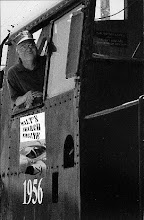The past is not dead, it's not even past

The past is not dead, it’s not even past
By Walter Haan, www.war-books.com, www.southfarmpress.com
Ralph M. Knox was the only witness left to General Douglas MacArthur and his entourage’s escape from the Japanese in the Philippines on March 17, 1942. Knox, a B-17 crew chief in the Army Air Force who was working 68 years ago at the airfield where MacArthur took off, asserted that the general had a third plane fixed to take out the personal possessions of his staff and family. Army Air Force personnel and nurses were left behind so that Mrs. MacArthur’s fur coats would not fall into the hands of the approaching Japanese, according to Knox.
I published, edited and designed the cover for the hardcover edition of Knox’s book, The Emperor’s Angry Guest, in 1999, in which he made the assertion above. The photo in the upper right pictures Knox showing his book to a famous POW of the Vietnam War, Senator John McCain.
I just found out this month that Knox died on November 25, 2008 in tragic circumstances. Knox evidently fell in front of his house, couldn’t get up and called for help. Neighbors did hear his call for help and looked but couldn’t find him when they went to look for the person calling out. He died of exposure that night on his front lawn at 86 years old.
Knox’s account of the three B-17s does not agree with historians’ versions, however, such as the one by William Manchester in his book American Caesar. Manchester and historian John Costello both claim that only two B-17s were used and that MacArthur’s group had to leave behind their personal possessions. But Air Force records from the period support Knox’s account about there being three planes used.
Knox explained in his book, The Emperor’s Angry Guest, that before loading the personal possessions of MacArthur's entourage, he and his teenage soldier buddies discovered the contents of the crates and footlockers while rummaging through them looking for cigarettes to steal. They didn’t find any cigarettes.
Instead they found the General’s pipe tobacco in the footlockers and crates of clothing packed up to be flown out. Knox and his buddies also loaded several straight back chairs, a rocking chair, and toys belonging to the general’s son in the third B-17.
“I am not going to back down about this. MacArthur sacrificed personnel to take out his stuff. I was there. I helped fix the third B-17 and helped load the possessions of MacArthur’s family and the officers in his staff,” Knox recounted. “I want the truth known.”
Knox and his buddies were captured by the Japanese on Mindanao on May 10, 1942. Knox spent 40 months as a prisoner-of-war and slave of the Japanese in the Philippines and Japan. He was transported twice by the Japanese in the holds of their infamous, unmarked "Hell Ships." He weighed 89 pounds when liberated by American troops in August 1945.
William Faulkner once said that “The past is not dead, it’s not even past.” It does seem that public memories of the past are now the battlefields of today. Knox, who lived in South Carolina, wanted to know, “Whose memory lives when the last survivor dies? The historians’ or the memory of someone who actually saw and participated in the event?” Knox and veterans like him have realized that this is their last chance to put their imprint on the historical events they actually lived.
A paperback version of The Emperor’s Angry Guest by Ralph M. Knox is still available from Trafford Publishing. It can be ordered from Trafford’s Web Site or from Amazon.com. I still recommend the book and salute the author who claimed rightly so that the American government ignored the Philippines in 1942 in favor of World War II Europe and later refused just compensation for the former POWs of Japan captured in the Philippines. —Copyright © 2010 by Walter Haan, www.war-books.com, www.southfarmpress.com

